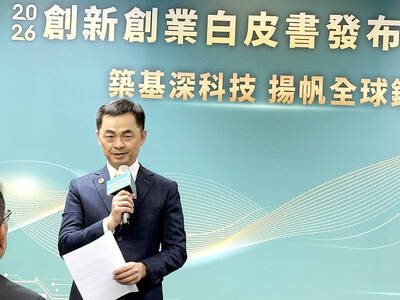Everest Textile Co (宏遠興業), which makes fabrics and garments, yesterday said two new plants in Ethiopia and the US are scheduled to start operations in the first half of this year.
The plant in Ethiopia is to manufacture garments for the company’s brand name customers from Europe, while the US facility is to supply knitted fabrics and garments to customers in the US, the firm said.
The two new factories are expected to increase the sales contribution from garments, which currently generate less than 2 percent of the company’s total sales, an Everest official said by telephone.
Revenue from woven and knitted fabrics accounts for more than 80 percent of the company’s total sales, while textured yarns generate nearly 10 percent, company data showed.
The official, who declined to be named, said the company plans to build another plant in Haiti because of lower labor costs.
“We have to keep seeking overseas sites for new factories, as the fabric manufacturing process is quite labor-intensive,” he told the Taipei Times.
Everest operates three plants in Taiwan, China and Thailand.
Everest’s local peers, including Lealea Enterprise Co (力麗) and Eclat Textile Co (儒鴻), also plan to accelerate overseas capacity expansion plans this year.
Lealea, which mainly produces textured polyester yarn, has approved a plan to invest as much as US$50 million in its first overseas factory in Indonesia.
The new plant is scheduled to begin operations in the first half of this year, with a target capacity of 4 million yards of polyester yarn per year, Lealea spokesman Chen Han-ching (陳漢卿) said by telephone yesterday.
The plant is to distribute about half of its products to customers in Indonesia, a nation of 255 million people, Chen said.
Lealea is also considering building another plant in Vietnam because of lower tariffs on exports to the EU, he added.
Local media reported that Eclat plans to expand production capacity in Vietnam after dissolving its wholly owned clothing plants in China last month.
Two new plants in Vietnam are scheduled to begin operations in the first and third quarters of this year respectively, and are expected to manufacture about 950,000 articles of clothing per month, boosting Eclat’s capacity by 20 percent annually, local media reported.

CHIP RACE: Three years of overbroad export controls drove foreign competitors to pursue their own AI chips, and ‘cost US taxpayers billions of dollars,’ Nvidia said China has figured out the US strategy for allowing it to buy Nvidia Corp’s H200s and is rejecting the artificial intelligence (AI) chip in favor of domestically developed semiconductors, White House AI adviser David Sacks said, citing news reports. US President Donald Trump on Monday said that he would allow shipments of Nvidia’s H200 chips to China, part of an administration effort backed by Sacks to challenge Chinese tech champions such as Huawei Technologies Co (華為) by bringing US competition to their home market. On Friday, Sacks signaled that he was uncertain about whether that approach would work. “They’re rejecting our chips,” Sacks

NATIONAL SECURITY: Intel’s testing of ACM tools despite US government control ‘highlights egregious gaps in US technology protection policies,’ a former official said Chipmaker Intel Corp has tested chipmaking tools this year from a toolmaker with deep roots in China and two overseas units that were targeted by US sanctions, according to two sources with direct knowledge of the matter. Intel, which fended off calls for its CEO’s resignation from US President Donald Trump in August over his alleged ties to China, got the tools from ACM Research Inc, a Fremont, California-based producer of chipmaking equipment. Two of ACM’s units, based in Shanghai and South Korea, were among a number of firms barred last year from receiving US technology over claims they have

BARRIERS: Gudeng’s chairman said it was unlikely that the US could replicate Taiwan’s science parks in Arizona, given its strict immigration policies and cultural differences Gudeng Precision Industrial Co (家登), which supplies wafer pods to the world’s major semiconductor firms, yesterday said it is in no rush to set up production in the US due to high costs. The company supplies its customers through a warehouse in Arizona jointly operated by TSS Holdings Ltd (德鑫控股), a joint holding of Gudeng and 17 Taiwanese firms in the semiconductor supply chain, including specialty plastic compounds producer Nytex Composites Co (耐特) and automated material handling system supplier Symtek Automation Asia Co (迅得). While the company has long been exploring the feasibility of setting up production in the US to address

OPTION: Uber said it could provide higher pay for batch trips, if incentives for batching is not removed entirely, as the latter would force it to pass on the costs to consumers Uber Technologies Inc yesterday warned that proposed restrictions on batching orders and minimum wages could prompt a NT$20 delivery fee increase in Taiwan, as lower efficiency would drive up costs. Uber CEO Dara Khosrowshahi made the remarks yesterday during his visit to Taiwan. He is on a multileg trip to the region, which includes stops in South Korea and Japan. His visit coincided the release last month of the Ministry of Labor’s draft bill on the delivery sector, which aims to safeguard delivery workers’ rights and improve their welfare. The ministry set the minimum pay for local food delivery drivers at